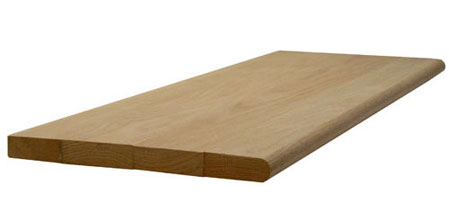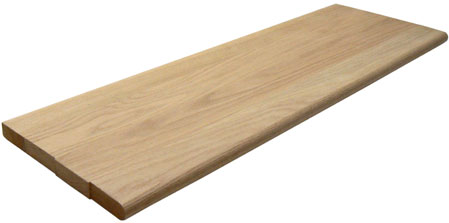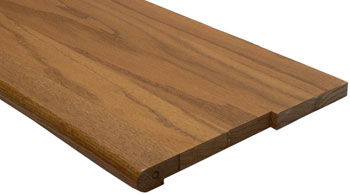Stair-Treads.com's premium quality edge glued stair treads are assembled with individual wood staves which are generally 2”-5” pieces of wood edge-glued together under extreme pressure with high-quality glue. You may notice these staves when viewing stair treads from the side but there are not bevels, gaps, or spaces between each piece that will be visible from the top. Once your treads are installed you will not be able to notice the staves and the tread will appear to be one solid piece. Edge glued stair treads are the industry standard for stair treads and are specifically designed to last longer and be a far superior construction choice to one piece treads.
"One piece treads," (a single 1" thick x 12" wide x 3-4' long slab of wood) are almost guaranteed to warp after installation due to normal job-site moisture fluctuations.
Imagine the steps on a deck that have been exposed to the elements - the cupping (wood curling) you see outside would occur on your interior steps but would be much worse because the lumber used for interior construction is kiln dried to a very low moisture (5-7%) and the exterior steps are made from lumber air dried to a much higher moisture level. Furthermore, single-piece stair treads would not only be costly and unstable, but also nearly impossible to construct from most wood species with today's forests. To construct a stair tread from a single piece of wood, you'd have to start with lumber from a tree that is large enough to yield lumber that is defect free in length, width, and thickness - a daunting task in itself if you've ever seen an optimizing saw at work. First and foremost, there are only a handful of species that are biologically capable of growing large enough to yield lumber for single slab treads (and most of them were harvested from the wild by the beginning of the last century). Many exotic trees (the ones that make the wood we've grown to love) only grow to what most of us would consider to be the size of a large shrub, thereby rendering it useless for anything but dollhouse steps. Most of today's lumber comes from sustainably managed forests, harvested at regular intervals, to yield predictable sizes of lumber. So granted, there may be a single slab of wood under the carpet of that 100-year-old home you're renovating, but the wood on that step has about as much in common with today's wood as the Model-T does with a modern pickup truck. We could bore you with more specific details, but we'll save that for a blog post.
The important thing to remember is that modern one piece treads are almost always made by small woodworking shops with a very specific application from a limited number of species (typically from either live-edge or reclaimed lumber). Many treads that appear to be made from one piece are actually a thin veneer laminated over a finger-jointed core material, or are actually the standard edge-glued treads with color-matched staves. If we made a single piece tread, it'd be virtually guaranteed to warp, crack, and cup in a very short time (typically with the first or second change in seasons or as soon as the air conditioner is turned on). One piece treads are almost guaranteed to fail (by most definitions of failure) in one way or another, and we do not offer one piece treads at Stair-Treads.com because we stand by our products as the premium standard in the construction industry and build our products to last the life of the home.
Advantage of edge glued stair treads
Staves prevent cupping and warping, look closely at the end of a tread and you'll see that the grain pattern of each piece of wood is reversed, thereby distributing the natural movement of the wood across the entire face of the tread and using the natural forces to reach equilibrium and keep your product smooth and level instead of the ends curling up every spring and fall. One piece treads are always more susceptible to cupping and warping, even if properly dried and milled. Our edge glued stair treads are factory glued with hydraulic clamps under thousands of pounds of force from the highest possible quality kiln-dried lumber. Because each stave is matched for color and grain, it is often virtually impossible to distinguish one stave from another and since the edge-glued panel is then planed and sanded many times before actually becoming a tread, there is no space or bevel between staves (basically the opposite of what hardwood flooring would look like if you glued it on your stairs). Our treads generally contain no more than five - six individual pieces of wood and no less than three, so you'll never have a bamboo look with your Oak treads. Check out our quality standards page for more detailed information about the premium standard for the construction of all of our stair treads.

*Unfinished Tread with 4 staves visible from the end grain

*Overhead view of the same unfinished tread (Notice how the tread appears to be one solid piece)
All of our treads are solid wood but made of individual staves for stability - a solid plank would not only be very expensive but also prone to cupping and warping. Each of our staves will be reversed grain to minimize cupping and is the only proper way to make a true solid stair tread. On average, you should expect 3-4 staves per tread but that's not guaranteed (depends on the rough lumber). No stave shall be less than 2 1/4" nor wider than 4" in width.
Our products will be the same wood from all the way through from top to bottom - no cheap veneers glued to a junk core!
Stair-Treads.com does not flush cut the ends of their treads after manufacturing

*Notice how the edges are left uncut
Perhaps one of the main reasons people learn about edge-glued stair tread construction with our products is because we don't flush cut the ends of our treads
If you study a competitor's product, the ends will be trimmed flush, but probably not square... and regardless, have you checked the walls or skirtboards in your staircase recently? We leave the ends "end wild" for a number of reasons but primarily it is because during our manufacturing process, we treat the ends of the lumber with a moisture barrier sealant (sometimes you can see the colored ends on the side of the tread). This step in the process is applied immediately after the raw material is cross cut, before it is ripped, glued, and dimensioned to a finished tread.
Changes in relative humidity can, and will cause all wood to either shrink or contract (regardless of what it is: flooring, stairs, furniture, etc). Most moisture escapes and absorbs through the end grain of wood (path of least resistance). When a stair tread loses or gains moisture through the end grain, it has a tendency to either cup, bow, or warp depending on the conditions. By sealing the ends, the tread is less apt to have these problems in non controlled climates such as job sites or warehouses. This allows the tread to be more impervious to changes in its environment until it is ready to be permanently secured on a finished staircase.
There is perhaps a bigger advantage however: you end up with a longer tread than you paid for. Instead of cutting it in our factory and chipping those precious 1/2-inches into horse bedding, you're afforded an extra saw blade or two of width; perfect for those last two steps that are somehow slightly longer than what you thought you measured.
For more in depth-information on the benefits of not flush cutting treads click here.











Log In